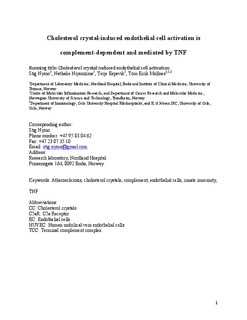Cholesterol crystal-induced endothelial cell activation is complement-dependent and mediated by TNF
Journal article, Peer reviewed
Permanent lenke
http://hdl.handle.net/11250/2381886Utgivelsesdato
2014Metadata
Vis full innførselSamlinger
Sammendrag
Cholesterol crystals are known to be a hallmark of atherosclerosis with recent studies demonstrating deposition of these crystals in early fatty streak formation as well as penetrating the intima following plaque rupture. Inflammation has also become a central focus in atheroma development and endothelial cell activation is recognized as necessary for the recruitment of inflammatory cells to the plaque. However, the extent to which cholesterol crystals can induce inflammation and activate endothelial cells is not known. To investigate this, we developed a novel model activating human umbilical vein endothelial cells using lepirudin anticoagulated human whole blood. We found that cholesterol crystals caused a marked and dose-dependent increase in the adhesion molecules E-selectin and ICAM-1 on the surface of the endothelial cells after incubation with whole blood. There was no activation of the cells when the crystals were incubated in medium alone, or in human serum, despite substantial crystal-induced complement activation in serum. Complement inhibitors at the C3 and C5 levels reduced the whole blood induced endothelial cell activation by up to 89% (p < 0.05) and abolished TNF release (p < 0.01). Finally, the TNF inhibitor infliximab reduced endothelial activation to background levels (p < 0.05). In conclusion, these data demonstrate that endothelial activation by cholesterol crystals is mediated by complement-dependent TNF release, and suggests that complement-inhibition might have a role in alleviating atherosclerosis-induced inflammation.
